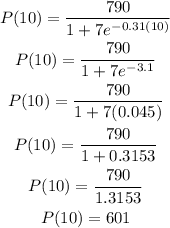Answer:
378 individuals
601 individuals
Step-by-step explanation:
We know that the population after t years is described by:

So, to know the population after 6 years, we need to replace t by 6 and calculate P(t). Then:

In the same way, we can calculate the population after 10 years replacing t by 10. So:

Therefore, the answers are:
378 individuals
601 individuals